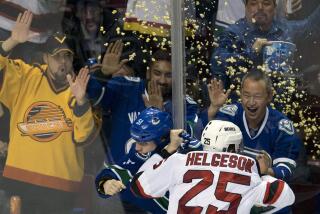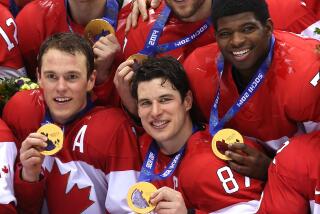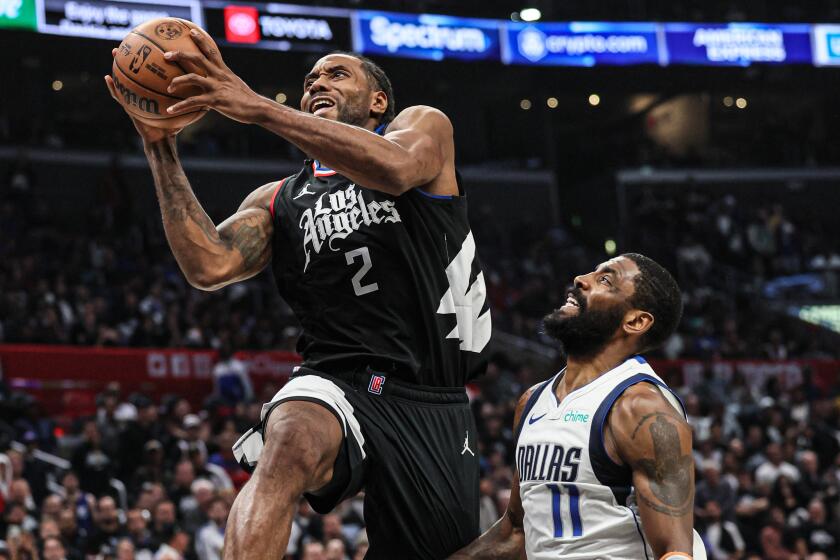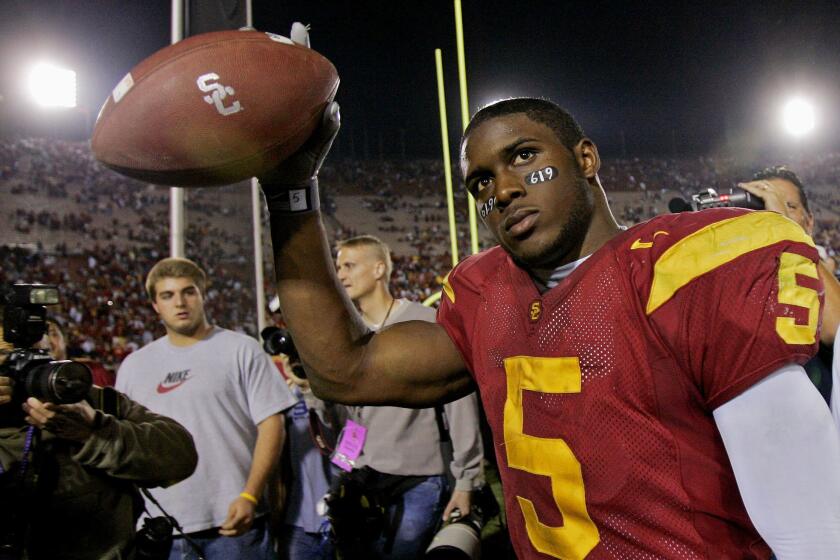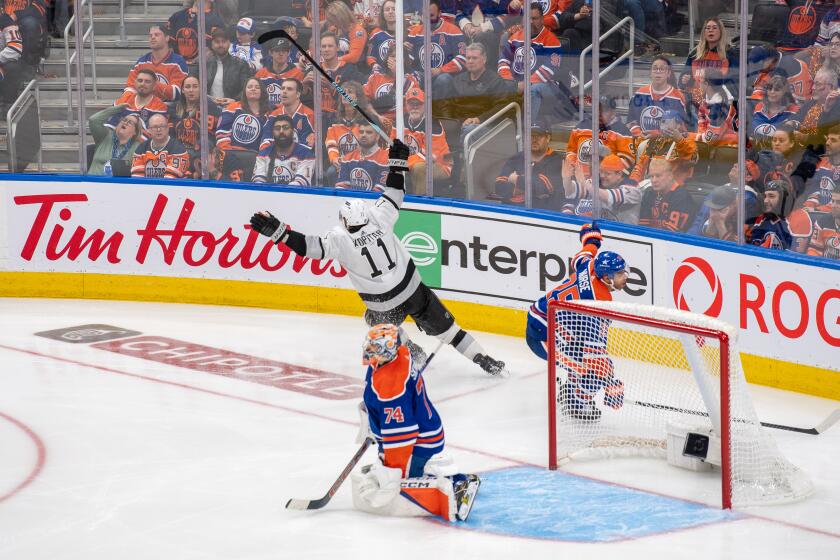Brendan Shanahan gives NHL’s disciplinary system some validity
The Stanley Cup has been hugged, kissed and photographed thousands of times and dented at least once since June, when the Boston Bruins defeated the Vancouver Canucks to win their first championship since 1972.
Fixing the damage caused when the Cup fell off a table was simple. Now the Bruins get the hard job: defending it.
The NHL season will begin Thursday with three games, including the Bruins playing host to the Philadelphia Flyers, and the Pittsburgh Penguins — minus concussion victim Sidney Crosby — at Vancouver. If there’s a theme to this season, it’s concern about blows to the head, prompted by hits that interrupted the careers of Crosby, St. Louis forward David Perron, Boston forward Marc Savard and others.
To signal that it’s serious and to clean up a murky disciplinary system, the NHL appointed former player Brendan Shanahan its senior vice president of hockey operations and player safety. He replaces Colin Campbell, whose unofficial title was vice president in charge of inconsistent calls and favoring his kid’s team.
Shanahan made an immediate impact by suspending nine players for 29 exhibitions and 31 regular-season games, costing them nearly $720,000. He accompanied each decision with a video in which he explained his ruling, casting the light of a thousand suns on the NHL’s darkest corners.
“The videos are done to provide clarity, but it’s also our goal and our hope not to be making videos,” Shanahan said last week. “But it’s an opportunity, even if it’s a team or a market that’s not involved in the suspension at all, to have a useful teaching tool. The videos are not meant in any way to embarrass anybody. It’s simply to be transparent to our players and to teach them, to educate them, and get their attention.
“I think up until now we didn’t do that. And the fact that we post them publicly is so that everybody that has a stake in the game — and I include the fans in that — will have a better understanding for the process that goes into making a decision. This is many of the same principles that Colin Campbell and his group did. The difference is we’re just allowing everyone to peek in and see.”
Shanahan attributed the deluge of preseason incidents to a combination of overeager players trying to impress coaches and veterans adjusting to new standards. He said he hadn’t heard a general manager tell him to slow down, “but I’d be naïve to not think that some are thinking that.”
He said the hockey operations department is merely following the wishes of general managers and the competition committee in making the game safer. Left unsaid is that it’s too bad it took life-altering concussions to get here.
“It’s one thing to say what you’re going to do in the off-season. It’s a lot harder when you’re trying to apply it, trying to make change,” Shanahan said of the new standards. “But we’re determined to stick with it.”
He hasn’t had to punish a star player yet. “But certainly I’m sure everybody’s waiting to see,” he said, aware of skepticism generated by the NHL’s habit of treating star players with a gentle hand.
In making his decisions, Shanahan said he looks at when an incident occurs to help establish intent, the injury that resulted, and the player’s history — but not the player’s fame.
“I’ve found them all challenging, regardless of whether it’s a player who hasn’t played NHL games yet or whether a superstar,” he said. “In some ways you know when you’re suspending a guy that’s trying to make the NHL you’re really, unfortunately, hurting his chances of earning a living in the NHL. So I don’t think that’s any less significant than a superstar.”
He also said he’s mindful of the impact on the victim, which wasn’t previously the case.
“I try to remain as balanced as I can but at the same time try and always remember that while the department wants the game physical and wants the game passionate, we also want it to be as safe as possible,” he said.
It’s safe to say he has made a good start.
New this season …
Punishment for boarding penalties was stiffened, and referees were given discretion to decide the severity of the penalty. In addition, “the onus is on the player applying the check to ensure his opponent is not in a defenseless position and if so, he must avoid or minimize contact.”
The wording of a rule punishing checks to the head was changed so any hit that targets an opponent’s head and is the principal point of contact is illegal. A minor penalty will be assessed and the referee can assess a match penalty if he believes there was a deliberate intent to injure.
Milestones
Jaromir Jagr has returned after three seasons in Russia’s KHL and becomes the NHL’s top active scorer, with 1,599 points, ninth on the career scoring list. Mike Modano’s retirement means Teemu Selanne is second among active scorers, with 1,340 points, and Detroit’s Nicklas Lidstrom is third at 1,108.
Lidstrom is six games from 1,500 in his stellar career. A few players are nearing 1,000 games: San Jose’s Joe Thornton is at 995, Montreal’s Hal Gill is at 994, New Jersey’s Dainius Zubrus is at 983 and Columbus’ Vinny Prospal is at 978.
On the horizon
This will be the final season under the current labor agreement between the league and the NHL Players’ Assn. The deal, forged after a lockout wiped out the 2004-05 season, expires Sept. 15. The NHLPA’s hiring of former baseball union boss Donald Fehr triggered speculation another labor war would erupt, but there are reasons to believe otherwise.
NHL owners in 2004 demanded a complete overhaul of the economic system to get a salary cap and other controls. They won those points, though they later sabotaged themselves by driving Zambonis through the loopholes. Owners don’t need an overhaul now — more like a massaging of existing provisions.
Expect the NHL to push for a limit on the length of contracts when talks begin, probably in the new year. Players’ participation in the 2014 Winter Olympics in Sochi, Russia, will be a key part of the negotiations.
Also in store: The Board of Governors will meet in December to discuss a potentially massive realignment for 2012-13. The Atlanta Thrashers’ move to Winnipeg to become the Jets occurred too late to realign this season, leaving Winnipeg awkwardly in the Southeast. Detroit and Columbus would like to move from the West to the East, which could lead to reconfigured divisions and conferences.
twitter.com/helenenothelen
More to Read
Get our high school sports newsletter
Prep Rally is devoted to the SoCal high school sports experience, bringing you scores, stories and a behind-the-scenes look at what makes prep sports so popular.
You may occasionally receive promotional content from the Los Angeles Times.
